- Details
- Published on 16 March 2020
Vol. 635
3. Cosmology
Reionization optical depth determination from Planck HFI data with ten percent accuracy
While it is true that the reionization optical depth determination has been greatly improved over the last two decades, tau is still the less constrained parameter of the lambdaCDM model. Uncertainties and systematics produce discrepant results for different large-scale CMB datasets (primarily Planck and WMAPS) and various methods. In this paper, the authors present an advanced approach to the Planck High Frequency Instrument (HFI) data using an improved version of the HFI map-making code, greatly reducing the residual large-scale contamination affecting the data. With large-scale polarization-only data, they measured tau = 0.0566 +0.0053 -0.0062 at 68% C.L., reducing the Planck 2018 legacy release uncertainty by ~40%. Within the lambdaCDM model, applied in combination with the Planck large scale temperature likelihood and the high-temperature and polarization likelihood, they measured tau = 0.059ą0.006 at 68% C.L. which corresponds to a mid-point reionization redshift of z re = 8.14ą0.61. This estimation of the reionization optical depth with 10% accuracy is the strongest constraint obtained to date.- Details
- Published on 09 March 2020
Vol. 635
12. Atomic, molecular, and nuclear data
Plasma-environment effects on K lines of astrophysical interest III. IPs, K thresholds, radiative rates, and Auger widths in Fe ix – Fe xvi
X-ray spectroscopy is the primary tool used to achieve an understanding of the inner zones of accretion flows in a wide variety of cosmic sources, particularly neutron stars and black holes. The resonance lines of highly ionized species of iron are among the most important spectral diagnostics available. This paper presents a novel, detailed study of the hitherto neglected ambient effects of plasma screeing and K transition wavelength shifts and thresholds, as well as the reduction in the ionizaton energies, on the interpretation of observations from the high-density environments expected in the inner portions of such flows.- Details
- Published on 06 March 2020
Vol. 635
6. Interstellar and circumstellar matter
High-precision polarimetry of nearby stars (d<50 pc)
Understanding the magnetic field of the interstellar medium (ISM) in the vicinity of the Sun is a supremely challenging task, requiring ultra-high-precision polarimetric measurements of as large a sample of stars with known distances as possible. This benchmark study uses a sample of 361 bright F and G stars to obtain UBV photometric polarimetry to a remarkable level, 10^(-5). A subset of the sample of nonactive stars shows some marginal evidence of variability, which is probably intrinsic. A key result is the delineation of large angular-scale coherent filamentary structures, which are detected in the position angle maps that correspond to features known from the local ISM. In particular, there is a signature of the Interstellar Boundary EXplorer (IBEX) ribbon that is connected with the local IS magnetic field, which was modified by the heliosphere. The study also shows correlations between high-latitude large arc structures revealed by samples at distances from 100 to 500 pc and those closer than 50 pc.- Details
- Published on 04 March 2020
Vol. 635
5. Galactic structure, stellar clusters and population
Hunting for open clusters in Gaia DR2: 582 new open clusters in the Galactic disc
 Open clusters have served as vital laboratories for the development and testing of stellar evolution theory. These clusters have also been fundamental for the exploration of the disk in our own Milky Way. The Gaia mission has now enabled the discovery study of massive numbers of Galactic star clusters. As such, the present discovery of 582 new open clusters using machine learning techniques is a treasure. These objects are very tricky to detect due to the high level of contamination related to their being embedded in the Galactic disk. They have been found as clear overdensities in the spatial and proper-motion parameter space, which was confirmed using Gaia optical photometry. Interestingly, the new data also facilitated the discovery of the tidal tails from an intermediate-age open cluster that is in the process of being disrupted by the Galactic tidal field, illustrating the potential of combining Gaia data with these modern machine learning techniques. A great deal of progress is expected to be made on this front in the future as we all eagerly await Gaia DR3.
Open clusters have served as vital laboratories for the development and testing of stellar evolution theory. These clusters have also been fundamental for the exploration of the disk in our own Milky Way. The Gaia mission has now enabled the discovery study of massive numbers of Galactic star clusters. As such, the present discovery of 582 new open clusters using machine learning techniques is a treasure. These objects are very tricky to detect due to the high level of contamination related to their being embedded in the Galactic disk. They have been found as clear overdensities in the spatial and proper-motion parameter space, which was confirmed using Gaia optical photometry. Interestingly, the new data also facilitated the discovery of the tidal tails from an intermediate-age open cluster that is in the process of being disrupted by the Galactic tidal field, illustrating the potential of combining Gaia data with these modern machine learning techniques. A great deal of progress is expected to be made on this front in the future as we all eagerly await Gaia DR3.
- Details
- Published on 25 February 2020
Vol. 634
Sect. 3. Cosmology
Contribution from stars stripped in binaries to cosmic reionization of hydrogen and helium
The presence of massive binary stars has been known to boost the production of ionizing radiation in the stellar populations: as such, it is extremely important to assess their contribution in the global ionizing budget during the reionization transition. In this work, the authors investigate the contribution of stars stripped of their hydrogen-rich envelopes in binaries. Such envelope-stripping is predicted to be the most common type of interaction in binaries as it is the fate of a third of all massive stars. Because stars over a wide range of masses can become stripped, the resulting ionizing radiation is emitted over an extended period of time after a starburst, therefore, these systems can boost the ionizing emission of stellar populations at late times. The authors find that stars stripped in binaries are likely to have had important effects on cosmic reionization since they could have provided ∼ 20% of the photons that reionized hydrogen in the Universe. On the other hand, the He ii-ionizing emission from stripped stars is not sufficient to compete with AGN and significantly impact the complete reionization of helium, although they might have contributed to the initial part of this process. Finally, the harder resulting spectra from stellar populations lead to an increased temperature of the IGM during reionization, although current high-redshift temperature measurements using the Lyα forest are probably not sensitive enough to detect such differences.
- Details
- Published on 12 February 2020
Vol. 634
6. Interstellar and circumstellar matter
The HI/OH/recombination line survey of the inner Milky Way (THOR): data release 2 and H I overview
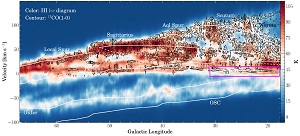 The Data Release 2 of The HI/OH/recombination line survey of the Milky Way (THOR) provides the most detailed view so far of the first Galactic quadrant at a 21 cm wavelength. The authors have combined observations from the Karl G. Jansky Very Large Array (VLA) and Green Bank Telescope (GBT) to recover the large-scale structure of the HI emission and achieve an angular resolution of 40". Among their results, the authors derive an opacity-correction factor that implies a total atomic gas mass of 9.4–10.5x10^9 M_sun when applied to the entire Milky Way.
The Data Release 2 of The HI/OH/recombination line survey of the Milky Way (THOR) provides the most detailed view so far of the first Galactic quadrant at a 21 cm wavelength. The authors have combined observations from the Karl G. Jansky Very Large Array (VLA) and Green Bank Telescope (GBT) to recover the large-scale structure of the HI emission and achieve an angular resolution of 40". Among their results, the authors derive an opacity-correction factor that implies a total atomic gas mass of 9.4–10.5x10^9 M_sun when applied to the entire Milky Way.
- Details
- Published on 23 January 2020
Vol. 633
In section 4. Extragalactic astronomy
Modeling spectral lags in active galactic nucleus flares in the context of Lorentz invariance violation searches
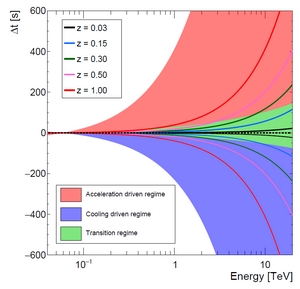
The paper indicates that intrinsic time delays, produced by acceleration and radiation mechanisms during blazar flares, can compromise searches for Lorentz invariance (LIV) violations at TeV energies. The authors simulated time dependent one-zone models, including inverse Compton and synchrotron losses. They concentrate on two acceleration regimes, long persistent and fast particle acceleration, and note that such spectral observations with the Cherenkov Telescope Array (CTA) will provide the new insights needed for active galactic nuclei (AGN) flare modeling, which will improve our ability to disentangle such systematics from LIV searches in the photon sector.
- Details
- Published on 21 January 2020
Vol. 633
Sect. 10. Planets and planetary systems
Planet formation around M dwarfs via disc instability. Fragmentation conditions and protoplanet properties

Around 30 percent of the observed exoplanets that orbit M dwarf stars are gas giants, which are more massive than Jupiter. The origin of these planets is uncertain since M dwarf disks are not massive enough for core accretion, that is, the coagulation of dust particles to progressively larger aggregates and eventually planets, to operate. In this paper the authors examine the possibility that such planets form by the alternative theory of disk instability. They performed an ensemble of hydrodynamic simulations of M dwarf disks in order to determine the minimum disk mass needed for gravitational fragmentation to occur. They find that a relatively high disk-to-star mass ratio is required of at least 0.3. The resolution of the simulations presented is high enough to determine the initial properties of the planets formed by disk instability. The planets form quickly (within a few thousand years) at distances around 50 AU from the host star, and they are initially very hot; their centers have temperatures up to 12,000 K. The authors argue that future observations of massive M dwarf disks or planets in very young M dwarf systems will establish the importance of disk instability for planet formation around low-mass stars.
- Details
- Published on 20 January 2020
Vol. 633
Sect. 10. Planets and planetary systems
Peering into the formation history of beta Pictoris b with VLTI/GRAVITY long-baseline interferometry
The 4th-magnitude beta Pictoris hosts an emblematic young planetary system that includes both one of the first debris disks, detected 30 years ago, and one of the first directly detected giant exoplanets a decade ago. Nowak et al. use the GRAVITY instrument on the VLT Interferometer to obtain both a high-quality R=500 K-band spectrum of the Beta Pic b planet and its position relative to the star with 50 microarcsecond accuracy. Together with archival astrometry, the new star-planet position indicates that their orbit is mildly eccentric and it improves previous mass measurements of the planet to 12.7 +- 2.2 Mjup mass. The authors also analyze the spectrum to derive a subsolar C/O abundance ratio in the planetary atmosphere, which points towards a formation of the planet through core accretion somewhere between the CO2 and H2O ice lines. Coupled with previous observations of the HR 8799 system, these observations demonstrate the great potential of spectrally resolved long baseline interferometry to characterize young planets and their formation mechanisms.
- Details
- Published on 17 January 2020
Vol. 633
Sect. 10. Planets and planetary systems
Formation of moon systems around giant planets Capture and ablation of planetesimals as foundation for a pebble accretion scenario
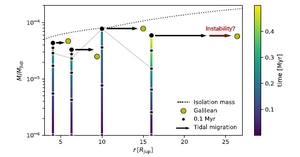
The formation of massive moons around giant planets, such as Jupiter and Saturn, is believed to take place in gaseous circum-planetary disks (CPDs), in a manner analogous to the formation of planets around stars. As a matter of fact, the jovian moons share many similarities with compact super-Earth and terrestrial-mass planet systems around solar-type stars and M-dwarfs. Yet, it remains unclear how the solid material needed to build the moons is brought to the CPDs of giant planets, as well as how the moons subsequently form and evolve out of this material. In this study, the authors show that planetesimals initially orbiting in the vicinity of a giant planet can be gravitationally captured when they interact with the gaseous CPD and experience, in most cases, sufficient frictional heating to be efficiently ablated, thereby feeding the planet’s disk with small dust grains. The authors demonstrate that the moons then mainly grow by accreting the pebbles that coagulate from the dust released via the ablation of planetesimals, and they rapidly migrate inward due to their tidal interaction with the gaseous CPD, resulting in their pile-up in resonant chains at the inner edge of the disk. Dynamical instabilities in these resonant chains could be at the origin of the different architectures of Jupiter’s and Saturn’s moon systems. This scenario is a direct analogy of the one proposed for the formation of super-Earths.
- Details
- Published on 15 January 2020
Vol. 633
1. Letters
The GALEX Ultraviolet Virgo Cluster Survey (GUViCS) VIII. Diffuse dust in the Virgo intra-cluster space
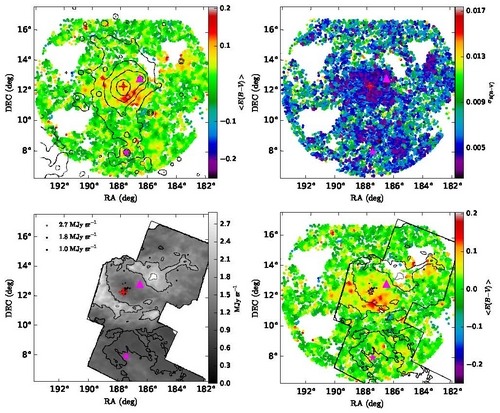 Dust is thought to be destroyed by sputtering in galaxy clusters, which are rich in X-ray emitting hot gas. However, some dust may still exist in shielded regions or from gas tails that have just been stripped from galaxies. Measurements of the amount of dust in clusters have derived extinctions between AV=0.004 and 0.5. The present work represents the first detection of diffuse dust in the intra-cluster medium of the Virgo cluster out to ~0.4 virial radius. The authors have used the near-ultraviolet-I colors of about 12000 background galaxies with redshifts 0.02 < z < 0.8, and find an average reddening E(B - V) ~ 0.042 mag within 1.5 degrees or 0.3 virial radius from the cluster’s center. Assuming a Large Magellanic Cloud extinction law, they derived an average visual extinction AV = 0.14, leading to a total dust mass of Md = 2.5 10^9Mo and hence a dust-to-gas mass ratio of Md/Mg = 3.0 x 10^-4, which is much lower than in the Milky Way. The far-infrared emission of the dust was not detected by Herschel at 250 micron; this means that either the dust temperature should be low, about 10 K, or that the dust has lower emissivity than usual. Nevertheless, this diffuse dust in the Virgo cluster must originate from the galaxies through tidal or ram-pressure stripping.
Dust is thought to be destroyed by sputtering in galaxy clusters, which are rich in X-ray emitting hot gas. However, some dust may still exist in shielded regions or from gas tails that have just been stripped from galaxies. Measurements of the amount of dust in clusters have derived extinctions between AV=0.004 and 0.5. The present work represents the first detection of diffuse dust in the intra-cluster medium of the Virgo cluster out to ~0.4 virial radius. The authors have used the near-ultraviolet-I colors of about 12000 background galaxies with redshifts 0.02 < z < 0.8, and find an average reddening E(B - V) ~ 0.042 mag within 1.5 degrees or 0.3 virial radius from the cluster’s center. Assuming a Large Magellanic Cloud extinction law, they derived an average visual extinction AV = 0.14, leading to a total dust mass of Md = 2.5 10^9Mo and hence a dust-to-gas mass ratio of Md/Mg = 3.0 x 10^-4, which is much lower than in the Milky Way. The far-infrared emission of the dust was not detected by Herschel at 250 micron; this means that either the dust temperature should be low, about 10 K, or that the dust has lower emissivity than usual. Nevertheless, this diffuse dust in the Virgo cluster must originate from the galaxies through tidal or ram-pressure stripping.
- Details
- Published on 15 January 2020
Vol. 633
Sect. 10. Planets and planetary systems
Magnetohydrodynamic simulations of a Uranus-at-equinox type rotating magnetosphere

Any solar system example provides a good departure point for understanding the physical processes and environments in the vastly diverse realm of exoplanetary systems. This is especially true for magnetospheres and interplanetary interactions with planetary magnetic fields. The Solar System example of Uranus is a remarkable oblique rotator whose magnetosphere shows long-time presentations of equatorial and polar-cusp to incoming supersonic flow. The authors study magnetohydrodynamic (MHD) simulations of an orthogonally-oriented planetary magnetosphere with incident unmagnetized and magnetized stellar wind flows. The magnetized wind induces reconnection and disconnection events as well as field distortions, some of which are more extreme than modeled for aligned fields. The neutral case shows field line distortions that produce puffs and tailward expulsions, especially in the rapidly rotting planetary model. While schematic at present, this paper demonstrates the tremendous promise of more physically realistic and computationally refined simulations to make significant observational predictions (e.g., auroral activity, nonthermal emission, and limits to atmospheric escape).
- Details
- Published on 15 January 2020
Vol. 633
Sect. 3. Cosmology
A gravitational lensing detection of filamentary structures connecting luminous red galaxies
In this cosmic web, large under-dense regions (voids) are enclosed by anisotropically collapsed surface structures (sheets) and line structures (filaments) which intersect at the most overdense isotropic regions (clusters). Simulations predict that as much as 40% of the mass in the Universe should be located in filaments, however, its detection poses a great challenge. Filaments have been detected by Xray emission and, recently, by the SZ signal. In this paper, the authors investigate the use of weak gravitational lensing to detect their presence combining three large public weak lensing surveys: KIDS+VIKING, RCSLenS, and the CFHTLenS to improve upon previous methodologies with the help of N-body simulations. As a result, they find a 3.4 σ detection of filamentary structure connecting luminous red galaxies separated by 3 − 5 h−1 Mpc, while they do not detect significant signals for larger separations, which is contrary to previous claims. The average density at the centre of these filamentary structures is found to be 15 ± 4 times the critical density.
- Details
- Published on 14 January 2020
Vol. 633
Sect. 4. Extragalactic astronomy
NGC 6240: A triple nucleus system in the advanced or final state of merging
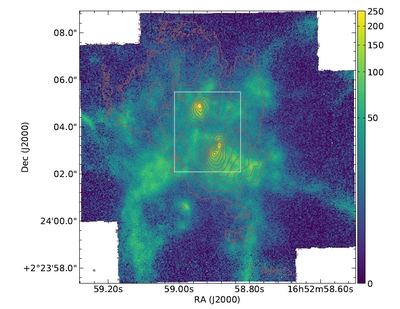
NGC6240 is a well known, nearby pair of merging galaxies. Optical, X-ray, and radio observations have shown that each galaxy of the pair hosts an active nucleus. MUSE on the VLT in the narrow-field mode with adaptive optics has allowed the authors to carry out a detailed optical 3D spectroscopic study with the very high spatial resolution of 75 mas (35 pc). The emission and absorption spectra, along with their dispersion, led the authors to claim that NGC6240 is, in fact, a system of three nuclei in the final state of merging. The southern component is indeed composed of two nuclei that are only separated by 198 pc. In combination with Gaia data, they reach an absolute positional accuracy of only 30 mas, which is essential to compare optical spectra with MERLIN/VLBA radio positions. In the NGC6240 system of three nuclei, two of them are active and all of them have a black hole mass in excess of 9 x 10^7Mo. This provides some insight into hierarchical galaxy formation via merging processes: It is known that multiple mergers lead to a faster evolution of massive galaxies in comparison to binary mergers. Triple massive black hole systems may accelerate the coalescence of a massive black hole, leading to the loudest sources of gravitational waves in the mHz regime.
- Details
- Published on 13 January 2020
Vol. 633
Sect. 1. Letters
First direct observation of a torsional Alfvén oscillation at coronal heights
The magnetized solar atmosphere can support a variety of waves. Torsional, or Alfvén waves, are promising candidates for transporting energy across different layers of the solar atmosphere and have been theoretically predicted for decades. Previous detections of Alfvén waves have, however, so far relied mostly on indirect signatures. Using data from the space-based IRIS observatory, the authors analyzed imaging and spectral observation of a surge of cool solar plasma which is triggered by a magnetic reconnection between open and closed magnetic field lines happening in the solar corona. The IRIS spectral data shows an oscillation in the line-of-sight velocity with a 180° phase difference at opposite edges of the surge flux tube. This signature of torsional oscillation is further complimented with an alternating tilt observable in the Si IV and Mg II k spectra across the flux tube and the trajectories traced by the individual threads of the surge material. Together these provide the first direct observational evidence that magnetic reconnection leads to the generation of large-scale torsional Alfvén waves in the solar corona.
- Details
- Published on 10 January 2020
Vol. 633
In section 1. Letters to the Editor
A stripped helium star in the potential black hole binary LB-1
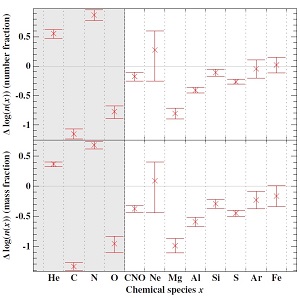
Very recently, the single-lined spectroscopic binary system LB-1 at a distance of 2.3kpc (inferred from the Gaia DR2 parallax) was claimed to contain a black hole of about 70 solar masses. This result is surprising, and would be completely at odds with current stellar evolution models as these do not predict such massive black holes in an environment that is as metal-rich as the Galactic solar neighborhood. In this Letter, the authors present a quantitative spectroscopic analysis of the visible component in LB-1 which reveals that this object is not an ordinary main sequence B-type star as previously assumed. Instead, the derived abundance pattern shows heavy imprints of hydrogen burning via the CNO bi-cycle, indicating that it is actually a stripped helium star. This result overturns the previous interpretation: the revised nature of the visible component significantly lowers the mass estimate to for the unseen companion, allowing values as low as 2-3 Msun; this is no longer in contradiction with stellar evolution models. The exact nature of the companion remains ambiguous for the time-being: it could be an ordinary black hole, a (massive) neutron star, or even a relatively unevolved main sequence star.
- Details
- Published on 10 January 2020
Vol. 633
6. Interstellar and circumstellar matter
A thin shell of ionized gas as the explanation for infrared excess among classical Cepheids
Cepheids have played a crucial role in the distance scale and determination of the present value of the Hubble constant H_0. This distance ladder is, however, mainly based on the period-luminosity relation and uncertainties around this relation are one of the largest contributors to the error of H_0. The IR excess of classical Cepheids is poorly understood but it is likely to affect the PL relation in a systematic way. The authors built a phase-independent spectral energy distribution (SED) of a sample of Cepheids from visible to mid-IR wavelengths, compared the SED to atmospheric models, and derived the IR excess features. Furthermore, they showed that the excess cannot be explained by a hot or cold dust model of the circumstellar environment. A free-free emission from a thin shell of ionized gas around Cepheids can reproduce the observed IR excess. Further investigation is needed to understand the impact of the presence of an ionized gas shell on the PL relation
- Details
- Published on 08 January 2020
Vol. 633
10. Planets and planetary systems
Explaining the low luminosity of Uranus: a self-consistent thermal and structural evolution

Unlike Jupiter, Saturn, and Neptune, which emit 1.7-2.6 times more energy than they receive from the Sun, Uranus has very low-to-zero intrinsic flux. This long-recognised feature has not been given any satisfactory explanation thus far. The low luminosity of Uranus indicates that its interior is non-adiabatic; either its internal energy has been lost or it remains captured in this interior. The former scenario is unsatisfying as it seems hard to understand why Uranus' interior would already be cold while the other outer planets remain in a cooling phase. Vazan and Helled explore the second possibility and, specifically, that a compositional gradient acts as a thermal boundary, isolating the inner hot region from the outer atmosphere, suppressing convection, and slowing down the cooling. They show that different types of composition gradients are stable over the planet's evolution time and can explain Uranus' observed radius, moment of inertia, and luminosity — without the need for artificial thermal boundaries. They also find that the initial energy content of Uranus was at most 20% of its accretion energy nd that convective mixing is limited in Uranus' outermost region. In contrast to Jupiter and Saturn, the atmosphere of Uranus today may not be very different from that of its primordial state.
- Details
- Published on 16 December 2019
Vol. 633
10. Planets and planetary systems
Effect of wind-driven accretion on planetary migration
 The authors compare the efficiency of the wind-driven accretion process with respect to the viscous accretion process in protoplanetary disks. They show that for the co-orbital region, this wind-driven process always injects mass from the outer edge of the co-orbital region and removes mass from the inner edge, while the viscous process does not. As a consequence, wind-driven accretion may strongly alter our formation scenarios.
The authors compare the efficiency of the wind-driven accretion process with respect to the viscous accretion process in protoplanetary disks. They show that for the co-orbital region, this wind-driven process always injects mass from the outer edge of the co-orbital region and removes mass from the inner edge, while the viscous process does not. As a consequence, wind-driven accretion may strongly alter our formation scenarios.


